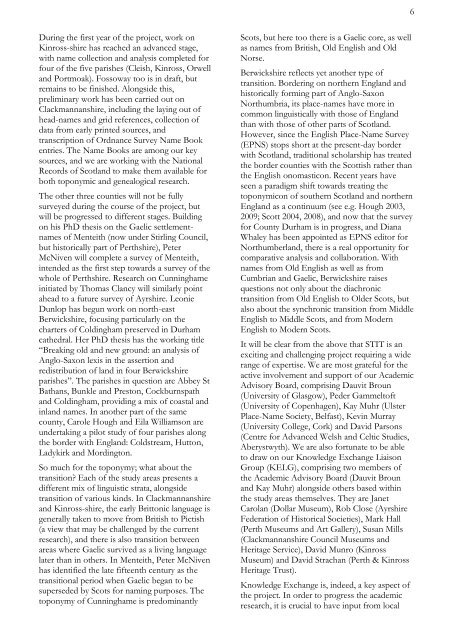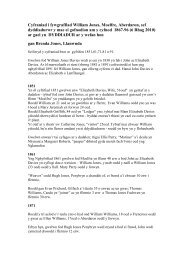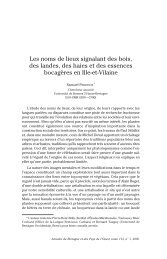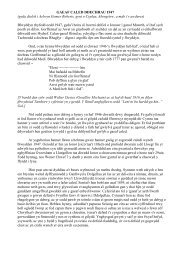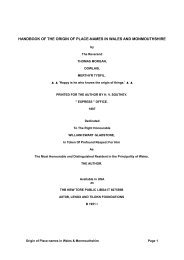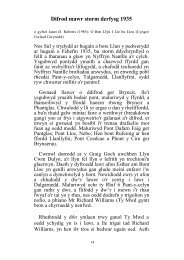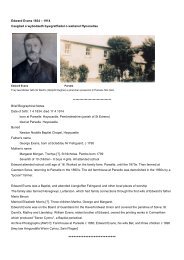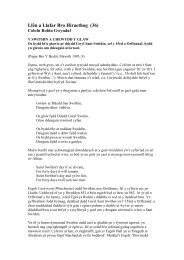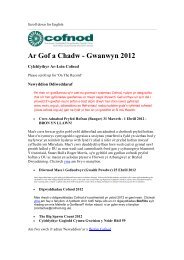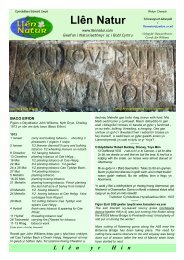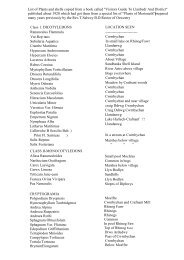new book: 'the place-names of bute'
new book: 'the place-names of bute'
new book: 'the place-names of bute'
Create successful ePaper yourself
Turn your PDF publications into a flip-book with our unique Google optimized e-Paper software.
During the first year <strong>of</strong> the project, work on<br />
Kinross-shire has reached an advanced stage,<br />
with name collection and analysis completed for<br />
four <strong>of</strong> the five parishes (Cleish, Kinross, Orwell<br />
and Portmoak). Fossoway too is in draft, but<br />
remains to be finished. Alongside this,<br />
preliminary work has been carried out on<br />
Clackmannanshire, including the laying out <strong>of</strong><br />
head-<strong>names</strong> and grid references, collection <strong>of</strong><br />
data from early printed sources, and<br />
transcription <strong>of</strong> Ordnance Survey Name Book<br />
entries. The Name Books are among our key<br />
sources, and we are working with the National<br />
Records <strong>of</strong> Scotland to make them available for<br />
both toponymic and genealogical research.<br />
The other three counties will not be fully<br />
surveyed during the course <strong>of</strong> the project, but<br />
will be progressed to different stages. Building<br />
on his PhD thesis on the Gaelic settlement<strong>names</strong><br />
<strong>of</strong> Menteith (now under Stirling Council,<br />
but historically part <strong>of</strong> Perthshire), Peter<br />
McNiven will complete a survey <strong>of</strong> Menteith,<br />
intended as the first step towards a survey <strong>of</strong> the<br />
whole <strong>of</strong> Perthshire. Research on Cunninghame<br />
initiated by Thomas Clancy will similarly point<br />
ahead to a future survey <strong>of</strong> Ayrshire. Leonie<br />
Dunlop has begun work on north-east<br />
Berwickshire, focusing particularly on the<br />
charters <strong>of</strong> Coldingham preserved in Durham<br />
cathedral. Her PhD thesis has the working title<br />
“Breaking old and <strong>new</strong> ground: an analysis <strong>of</strong><br />
Anglo-Saxon lexis in the assertion and<br />
redistribution <strong>of</strong> land in four Berwickshire<br />
parishes”. The parishes in question are Abbey St<br />
Bathans, Bunkle and Preston, Cockburnspath<br />
and Coldingham, providing a mix <strong>of</strong> coastal and<br />
inland <strong>names</strong>. In another part <strong>of</strong> the same<br />
county, Carole Hough and Eila Williamson are<br />
undertaking a pilot study <strong>of</strong> four parishes along<br />
the border with England: Coldstream, Hutton,<br />
Ladykirk and Mordington.<br />
So much for the toponymy; what about the<br />
transition? Each <strong>of</strong> the study areas presents a<br />
different mix <strong>of</strong> linguistic strata, alongside<br />
transition <strong>of</strong> various kinds. In Clackmannanshire<br />
and Kinross-shire, the early Brittonic language is<br />
generally taken to move from British to Pictish<br />
(a view that may be challenged by the current<br />
research), and there is also transition between<br />
areas where Gaelic survived as a living language<br />
later than in others. In Menteith, Peter McNiven<br />
has identified the late fifteenth century as the<br />
transitional period when Gaelic began to be<br />
superseded by Scots for naming purposes. The<br />
toponymy <strong>of</strong> Cunninghame is predominantly<br />
Scots, but here too there is a Gaelic core, as well<br />
as <strong>names</strong> from British, Old English and Old<br />
Norse.<br />
Berwickshire reflects yet another type <strong>of</strong><br />
transition. Bordering on northern England and<br />
historically forming part <strong>of</strong> Anglo-Saxon<br />
Northumbria, its <strong>place</strong>-<strong>names</strong> have more in<br />
common linguistically with those <strong>of</strong> England<br />
than with those <strong>of</strong> other parts <strong>of</strong> Scotland.<br />
However, since the English Place-Name Survey<br />
(EPNS) stops short at the present-day border<br />
with Scotland, traditional scholarship has treated<br />
the border counties with the Scottish rather than<br />
the English onomasticon. Recent years have<br />
seen a paradigm shift towards treating the<br />
toponymicon <strong>of</strong> southern Scotland and northern<br />
England as a continuum (see e.g. Hough 2003,<br />
2009; Scott 2004, 2008), and now that the survey<br />
for County Durham is in progress, and Diana<br />
Whaley has been appointed as EPNS editor for<br />
Northumberland, there is a real opportunity for<br />
comparative analysis and collaboration. With<br />
<strong>names</strong> from Old English as well as from<br />
Cumbrian and Gaelic, Berwickshire raises<br />
questions not only about the diachronic<br />
transition from Old English to Older Scots, but<br />
also about the synchronic transition from Middle<br />
English to Middle Scots, and from Modern<br />
English to Modern Scots.<br />
It will be clear from the above that STIT is an<br />
exciting and challenging project requiring a wide<br />
range <strong>of</strong> expertise. We are most grateful for the<br />
active involvement and support <strong>of</strong> our Academic<br />
Advisory Board, comprising Dauvit Broun<br />
(University <strong>of</strong> Glasgow), Peder Gammelt<strong>of</strong>t<br />
(University <strong>of</strong> Copenhagen), Kay Muhr (Ulster<br />
Place-Name Society, Belfast), Kevin Murray<br />
(University College, Cork) and David Parsons<br />
(Centre for Advanced Welsh and Celtic Studies,<br />
Aberystwyth). We are also fortunate to be able<br />
to draw on our Knowledge Exchange Liaison<br />
Group (KELG), comprising two members <strong>of</strong><br />
the Academic Advisory Board (Dauvit Broun<br />
and Kay Muhr) alongside others based within<br />
the study areas themselves. They are Janet<br />
Carolan (Dollar Museum), Rob Close (Ayrshire<br />
Federation <strong>of</strong> Historical Societies), Mark Hall<br />
(Perth Museums and Art Gallery), Susan Mills<br />
(Clackmannanshire Council Museums and<br />
Heritage Service), David Munro (Kinross<br />
Museum) and David Strachan (Perth & Kinross<br />
Heritage Trust).<br />
Knowledge Exchange is, indeed, a key aspect <strong>of</strong><br />
the project. In order to progress the academic<br />
research, it is crucial to have input from local<br />
6


